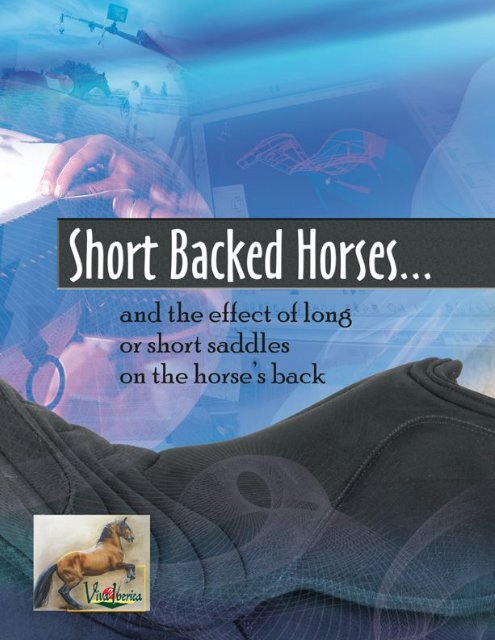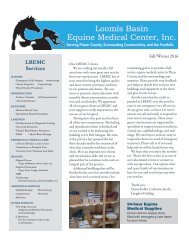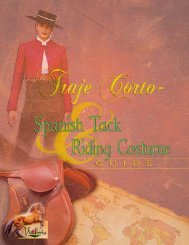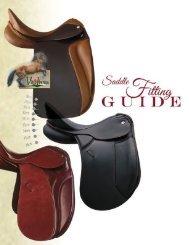Viva Iberica's 2015 Short Backed Horses
Traditional opinion says that horses with short backs require short saddles, based on the simple logic that a short horse = short back = short saddle. Sometimes short backed horses suffer back problems despite a ‘short’ saddle being used and this, as well as a desire to better understand the effects saddles have on the horse, led Zaldi Sillas de Montar S.A. in Salamanca Spain to carry out significant research, which included working with the CIDAUT Foundation, into this potential problem. Their findings have been interesting; endorsing their understanding of how the panels – these are the two long undersides of the saddle that sit on the horse – if made correctly can spread the load evenly along the horses back.
Traditional opinion says that horses with short backs require short saddles, based on the simple logic that a short horse = short back = short saddle. Sometimes short backed horses suffer back problems despite a ‘short’ saddle being used and this, as well as a desire to better understand the effects saddles have on the horse, led Zaldi Sillas de Montar S.A. in Salamanca Spain to carry out significant research, which included working with the CIDAUT Foundation, into this potential problem. Their findings have been interesting; endorsing their understanding of how the panels – these are the two long undersides of the saddle that sit on the horse – if made correctly can spread the load evenly along the horses back.
Create successful ePaper yourself
Turn your PDF publications into a flip-book with our unique Google optimized e-Paper software.
<strong>Short</strong> <strong>Backed</strong> <strong>Horses</strong>...<br />
and the effect of long or short saddles on the horse’s back<br />
by Richard Lust<br />
Traditional opinion says that horses with short backs<br />
require short saddles, based on the simple logic that a<br />
short horse = short back = short saddle.<br />
Sometimes short backed horses suffer back problems<br />
despite a ‘short’ saddle being used and this, as well as a<br />
desire to better understand the effects saddles have on<br />
the horse, led Zaldi Sillas de Montar S.A. in Salamanca<br />
Spain to carry out significant research, which included<br />
working with the CIDAUT Foundation, into this<br />
potential problem. Their findings have been interesting;<br />
endorsing their understanding of how the panels<br />
– these are the two long undersides of the saddle that<br />
sit on the horse – if made correctly can spread the load<br />
evenly along the horses back.<br />
There is a theory that the horse’s 18th rib, i.e. the first rib<br />
behind those connected to the rib cage, is vulnerable<br />
if the saddle rests on it and can give rise to back pain<br />
and possible long term problems. So if this theory is<br />
taken into account then the difficulty comes in trying<br />
to make a saddle that reaches no further back than the<br />
17th, because in most cases it need to be a very short<br />
saddle, which may not be suitable for many riders.<br />
What is often neglected here is that the shorter the<br />
panel the more the rider’s weight is concentrated over<br />
a smaller area, which means a greater pressure per<br />
square inch/cm on the horse. Critically, weight may be<br />
concentrated precisely in the area where the intention<br />
is to relieve the horse, i.e. at the rear/end of the panel,<br />
directly over or close to rib 18.<br />
Obviously the longer the panel the better the weight<br />
can be distributed without localised pressure, however<br />
it is useful to understand how the panels should function<br />
on a well-designed saddle. Firstly consider a ‘short’<br />
saddle and that it will inevitably have a ‘short’ panel<br />
– diagram 2.<br />
The end of the short panel is more or less directly under<br />
the back of the saddle where the weight of the rider<br />
is often concentrated and this can create a pressure<br />
point at the end. This is accentuated when riders lean<br />
backwards, especially with the style adopted by many<br />
in modern dressage today. See diagram 4.<br />
The diagram shows where weight can be concentrated,<br />
The diagram shows where weight can be concentrated<br />
and especially when a rider leans back in the saddle<br />
www.webshop.viva-iberica.com Page 3
especially when a rider leans back in the saddle<br />
Not only is a pressure point in this region undesirable<br />
but could be above or close to the 18th rib.<br />
.<br />
Saddles with short panels will usually look as if they<br />
make a complete contact along the horse’s back when<br />
placed on the horse without the rider mounted, so they<br />
may appear correct, but the panels in this unloaded<br />
state (without the rider’s weight) should not appear to<br />
have complete contact along all their length including<br />
the very end point because the function of the<br />
panel should be to soften and expand the rider’s weight<br />
without creating any point of pressure. To make things<br />
worse this often fairly inflexible end of the panel can<br />
focus the weight of the rider onto that localised point at<br />
the back of the saddle. Just where it is not wanted.<br />
Now consider a longer panel. On a well-designed and<br />
fitted saddle, placed on a horse without a rider, the<br />
panel will curve away from the horse’s back at the end<br />
– see diagram 1<br />
Then when the rider’s weight is applied (especially if<br />
the rider leans backwards) the panel can soften and<br />
expand without creating a pressure point – see<br />
diagram 3.<br />
There is no focal point right at the end of the saddle<br />
beneath the point of maximum load and so the load is<br />
spread and distributed over a greater area.<br />
Technical research and saddle development has been<br />
one of Zaldi’s key objectives and has led them to work<br />
with third party technical organisations, for example<br />
the CIDAUT Foundation, a technical research organisation<br />
with facilities in Germany, Latin America and<br />
Spain. This has enabled sophisticated evaluation on the<br />
effects of saddle panels, saddle trees and related design<br />
aspects using modern technological methods, so they<br />
have reliable results not theories to take into consideration<br />
in new saddle design. The conclusion is that more<br />
harm may be done by trying to make an especially<br />
short saddle to fit a short backed horse.<br />
Regardless of the horse’s back length, the rider still<br />
needs the same space in which to sit on the saddle and<br />
the same weight has to be distributed, so obviously the<br />
saddle seat cannot be shortened as the rider will not fit.<br />
The conclusion until now has been to shorten the panel,<br />
but in doing so localised pressure may be increased just<br />
where it needs to be avoided.<br />
This is a factor influencing Zaldi’s design where the<br />
rear of the saddle is shaped, slightly extended and<br />
‘softened’ in order to spread the load over a greater<br />
area and dissipate the rider’s weight.<br />
A typical request often heard by saddlers is from a<br />
rider wanting say an 18” seat but with very short panels<br />
because the horse has a short back. If such a saddle is<br />
made then clearly it could harm the horse with a high<br />
pressure concentrated at the back of the panel under<br />
the centre of the rider’s weight - so what is the answer?<br />
Is it a smaller rider or a longer backed horse? Or should<br />
it be a saddle that spreads the weight properly - for the<br />
horse’s sake.<br />
©COPYRIGHT: October <strong>2015</strong><br />
Yeguada Iberica®<br />
Photographs are reproduced with the permission of Zaldi S.A., Salamanca, España.<br />
Photos may not be copied or reproduced without the owner’s express permission.<br />
Publication Design by www.BTLDesigns.com<br />
<strong>Viva</strong> Iberica / Yeguada Iberica, Apartado de Correos 74, 02500-Tobarra, (Albacete), España<br />
E-mail: info@viva-iberica.com<br />
Additional information is available<br />
www.viva-iberica.com<br />
Page 4<br />
<strong>Short</strong> <strong>Backed</strong> <strong>Horses</strong>
www.viva-iberica.com
















